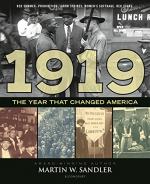|
This section contains 679 words (approx. 2 pages at 400 words per page) |

|
1919 The Year That Changed America Summary & Study Guide Description
1919 The Year That Changed America Summary & Study Guide includes comprehensive information and analysis to help you understand the book. This study guide contains the following sections:
This detailed literature summary also contains Topics for Discussion on 1919 The Year That Changed America by Martin W. Sandler.
The following version of the book was used to create this study guide: Sandler, Martin W. 1919: The Year That Changed America. Bloomsbury Children's Books, 2019. Amazon Kindle eBook.
Author Martin W. Sandler proposes that the year 1919 was one of the most "remarkable and important years in the history of the United States" (4). The events of that year were significant and left a lasting impact on the country. Furthermore, they can inform both how we arrived at our present-day circumstances as well as in what areas the United States needs to continue to evolve and change. In this book, Sandler explores six major events that occurred in 1919 and draws parallels between the past and the present.
The first big event Sandler writes about is the Great Molasses Flood. This disaster occurred in 1919, when a poorly made storage tank filled with 2.3 million gallons of molasses exploded in the North End of Boston. A flood of molasses destroyed surrounding homes, railways, and even the fire station; many lives were tragically lost. The aftermath of this disaster prompted states across the country, beginning with Massachusetts, to implement laws and regulations around building codes and engineering so that such a tragedy could not recur. Chapter 2 covers the women's suffrage movement, which succeeded in its efforts to grant women the right to vote in 1919. Sandler writes about the campaign effort of suffragists, which included picketing, marches, and hunger strikes. Many suffragists were arrested and mistreated in prison, winning greater support for their cause. Sandler also notes that there was racism within this movement which favored white women and often excluded women of color.
The issue of race relations at the time is addressed in more detail in Chapter 3: The Red Summer. The Red Summer is a name given to a series of months in 1919 in which several violent, destructive, and deadly race riots occurred across the country. Sandler writes about the racial discrimination and inequality that prompted many of these riots, as well as the culture of lynching and violent white supremacy that was prominent at the time. He writes in detail about riots in Washington DC, Chicago, and Elaine, Arkansas. In all of these instances, black people suffered much more than white people and the systemic racism in the country, particularly on the part of law enforcement officers, became clear. Chapter 4 is about the persecution of suspected Communists, a crusade led by Attorney General Palmer beginning in 1919. Fearful that Communism would spread from Russia to the United States, Palmer targeted, arrested, and deported suspected Communist sympathizers. Most of these people were immigrants who were targeted because of their backgrounds. Palmer's practices commonly abused civil rights and liberties, deporting people without trial and arresting them without evidence.
Chapter 5 focuses on a series of labor strikes that occurred in 1919. After beginning with the story of the country's first general strike, which happened in Seattle, Sandler then writes about the Boston Police Strike and the Great Steel Strike. These events and others were indicative of the need for better pay, working hours, and labor conditions. While each of these strikes was ultimately unsuccessful, they laid the groundwork for a shift in the relationship between employers and employees, and labor conditions in the country would change significantly in the coming years. The final chapter is devoted to a discussion of Prohibition, which banned the sale, manufacture, and distribution of alcohol in the United States for over a decade. Prohibition was a failed endeavor as people found ways to get alcohol through bootlegging, smuggling, and organized crime. Corruption and crime were rampant, and the government lacked the resources to enforce the law effectively, leading to its eventual repeal.
In a short conclusion, Sandler notes the links between these separate events, as well as their links to current contemporary society. He concludes by emphasizing that: "We can look back at these moments and track these movements as they evolved during the following one hundred years to learn that the arc of history is long and varied and gives the trials and triumphs of our own time some added perspective" (183).
Read more from the Study Guide
|
This section contains 679 words (approx. 2 pages at 400 words per page) |

|



